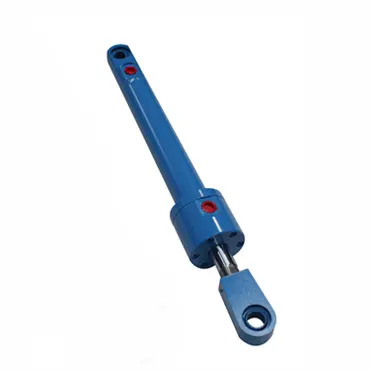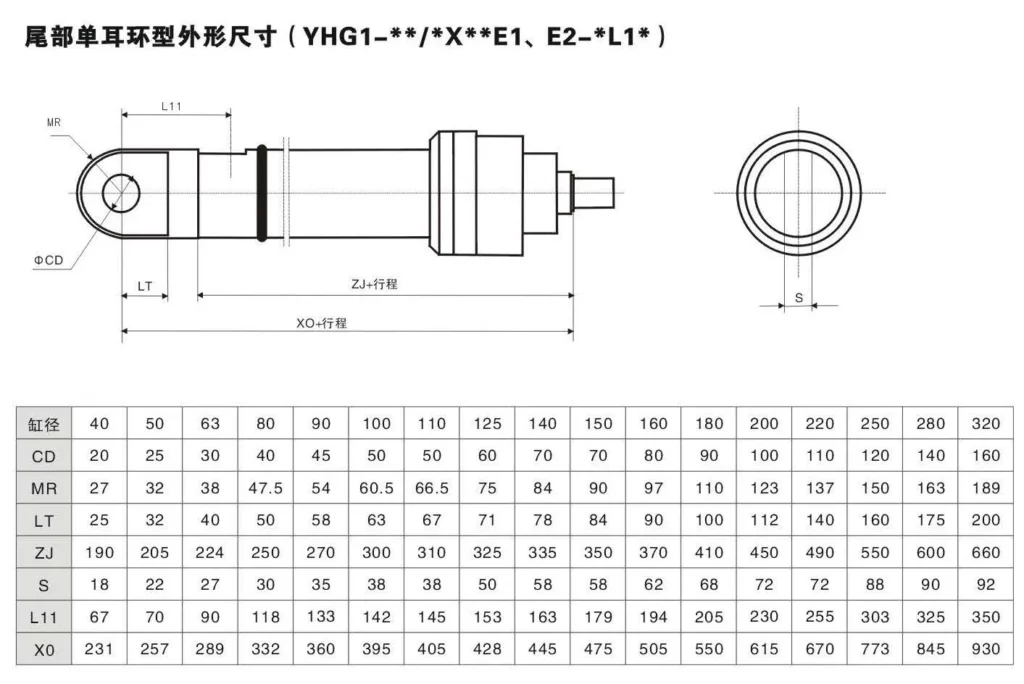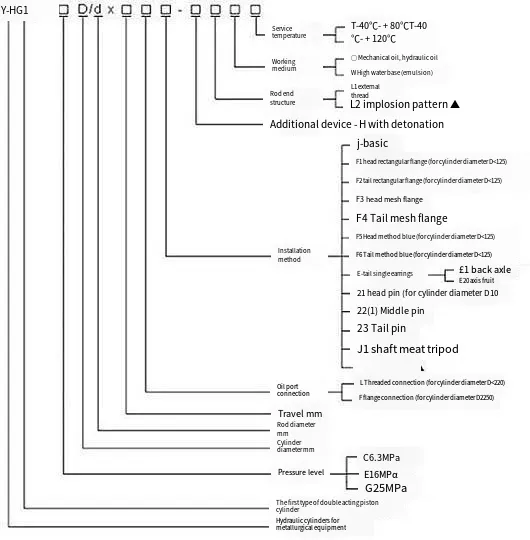Y-HG1 Metallurgical Hydraulic Cylinder
Fiind unul dintre producătorii, furnizorii și exportatorii de cilindri hidraulici, oferim cilindri hidraulici și multe alte produse.
Vă rugăm să luați legătura cu noi pentru detalii.
Mail:sales@hydraulic-cylinders.net
Producător, furnizor, exportator de cilindri hidraulici.
Y-HG1 Metallurgical Hydraulic Cylinder
Y-HG1 series metallurgical equipment hydraulic cylinder is a double-acting piston cylinder, and the cylinder diameter is generally in the range of 40~320mm, the working pressure <=16MPA, the hydraulic oil mechanical system can be used for milk transport and other working medium, installation flange, earrings, pins, release device (base) and different types.
High precision CNC honing machine, automatic welding machine, vertical, horizontal machining center, gantry machining center, CNC lathe, and other processing equipment, product quality is stable and guaranteed.

Metallurgical Hydraulic Cylinder Parameter:
(1)Axial Tripod Type Metallurgical Hydraulic Cylinder Parameter
(2)Head Method Orchid Type Metallurgical Hydraulic Cylinder
(3)Head Pin Type Metallurgical Hydraulic Cylinder
(4)Head Rectangular Flange Type Metallurgical Hydraulic Cylinder
(5)Head Round Flange Type Metallurgical Hydraulic Cylinder
(6) Middle Pin Type Metallurgical Hydraulic Cylinder
(7)Rear Method Orchid Type Metallurgical Hydraulic Cylinder
(8)Rear Pin Type Metallurgical Hydraulic Cylinder
(9)Rear Rectangular Flange Type Metallurgical Hydraulic Cylinder
(10)Rear Round Flange Type Metallurgical Hydraulic Cylinder

(11)Rear Single Earring Type Metallurgical Hydraulic Cylinder

(12) Y-HG1 Noraml Metallurgical Hydraulic Cylinder
Metallurgical Hydraulic Cylinder Technical Parameter:
Model example: Y-HG1-E40/22*50LJ1L10T1

Cilindru hidraulic metalurgic Scope Of Application:
The hydraulic cylinder of Y-HG1 series metallurgical equipment is a double-acting piston cylinder. The cylinder diameter is generally in the range of 40~320mm, and the working pressure <=16MPA; its basic parameters include cylinder diameter, rod diameter, stroke, oil port size, and so on.
How To Take Apart A Hydraulic Cylinder?
Taking apart a hydraulic cylinder requires careful disassembly to avoid damage and ensure safe handling. Here are the general steps to follow:
- Safety Precautions:
- Ensure the hydraulic system is depressurized and the cylinder is in a retracted position.
- Use appropriate personal protective equipment, such as gloves and safety glasses.
- Prepare a clean and organized workspace with adequate lighting and ventilation.
- Identify Cylinder Components:
- Familiarize yourself with the different parts of the hydraulic cylinder, including the cylinder body, piston, rod, seals, and end caps.
- Remove External Connections:
- Disconnect any hydraulic hoses, fittings, or other external connections attached to the cylinder.
- Use appropriate tools, such as wrenches or pliers, to loosen and remove the connections carefully.
- Secure the Cylinder:
- Place the cylinder securely in a vise or similar holding fixture, ensuring it is stable and won’t move during disassembly.
- Remove the Rod End Cap:
- Locate the rod end cap, which is typically situated at the end of the cylinder opposite the piston.
- Use the appropriate wrench or socket to loosen and remove the bolts securing the rod end cap.
- Tap the end cap gently with a rubber mallet if needed to break any seal or adhesive bond.
- Separate the Rod and Piston Assembly:
- Once the rod end cap is removed, carefully slide the rod and piston assembly out of the cylinder body.
- Support the weight of the assembly to prevent it from falling or causing damage.
- Disassemble the Rod and Piston Assembly:
- Examine the rod and piston assembly for retaining rings, snap rings, or other retaining devices.
- Use appropriate tools, such as pliers or snap ring pliers, to remove these retaining devices, allowing the disassembly of the assembly into its individual components.
- Take note of the order and orientation of each component for reassembly.
- Inspect and Clean:
- Inspect all the disassembled components for wear, damage, or signs of leakage.
- Clean each component thoroughly using an appropriate solvent or cleaning agent to remove dirt, debris, and hydraulic fluid residue.
- Dry the components completely before reassembly.
- Reassembly or Component Replacement:
- If necessary, replace any damaged or worn components with new ones following the manufacturer’s specifications.
- Reassemble the hydraulic cylinder in the reverse order of disassembly, ensuring proper alignment and orientation of components.
- Tighten bolts or fasteners to the manufacturer’s recommended torque specifications.
Capabilitatea și capacitatea fabricii:
(1) Montaj
Avem o platformă de asamblare independentă de cercetare și dezvoltare de primă clasă. Atelierul de producție a cilindrilor hidraulici are patru linii de asamblare semiautomate pentru cilindri de ridicare și o linie de asamblare automată a cilindrilor de înclinare, cu o capacitate de producție anuală proiectată de 1 milion de bucăți. Atelierul de cilindri speciali este echipat cu diverse specificații ale unui sistem de asamblare semi-automat de curățare, cu o capacitate de producție anuală proiectată de 200.000 și dotat cu echipamente celebre de prelucrare CNC, un centru de prelucrare, un echipament special de prelucrare a cilindrilor de înaltă precizie, o mașină de sudură robotizată, o mașină de curățare automată, o mașină de asamblare automată a cilindrilor și o linie de producție automată de vopsire. Echipamente critice existente de peste 300 de seturi (seturi). Alocarea optimă și utilizarea eficientă a resurselor de echipamente asigură cerințele de precizie ale produselor și satisface nevoile de înaltă calitate ale produselor.


(2) Prelucrare
Atelierul de prelucrare este echipat cu un centru de strunjire cu șină înclinată personalizat, un centru de prelucrare, o mașină de honuire de mare viteză, un robot de sudură și alte echipamente conexe, care pot gestiona prelucrarea tuburilor cilindrice cu un diametru interior maxim de 400 mm și o lungime maximă de 6 metri.

(3) Sudură

(4) Vopsire și acoperire
Cu linii automate de acoperire cu vopsea pe bază de apă cu cilindru de dimensiuni mici și medii, pentru a realiza încărcarea și descărcarea automată a robotului și pulverizarea automată, capacitatea de proiectare de 4000 de bucăți pe schimb;
Avem, de asemenea, o linie de producție semi-automată de vopsire pentru cilindri mari, acționată de un lanț de putere, cu o capacitate de proiectare de 60 de cutii pe schimb.


(5) Testarea
Dispunem de instalații de inspecție și bancuri de testare de primă clasă pentru a ne asigura că performanța cilindrului îndeplinește cerințele.

We are one of the best metallurgical hydraulic cylinder manufacturers. We can offer comprehensive metallurgical hydraulic cylinder stock. We also provide corresponding cutii de viteze agricole. We have exported our products to clients worldwide and earned a good reputation because of our superior product quality and after-sales service. We welcome customers at home and abroad to contact us to negotiate business, exchange information, and să coopereze cu noi!
Faceți un tur al fabricii noastre VR:
Faceți un tur al fabricii noastre VR cu următoarele
Cum funcționează cilindrul hidraulic pentru stivuitor?
Cilindru hidraulic Aplicație:













